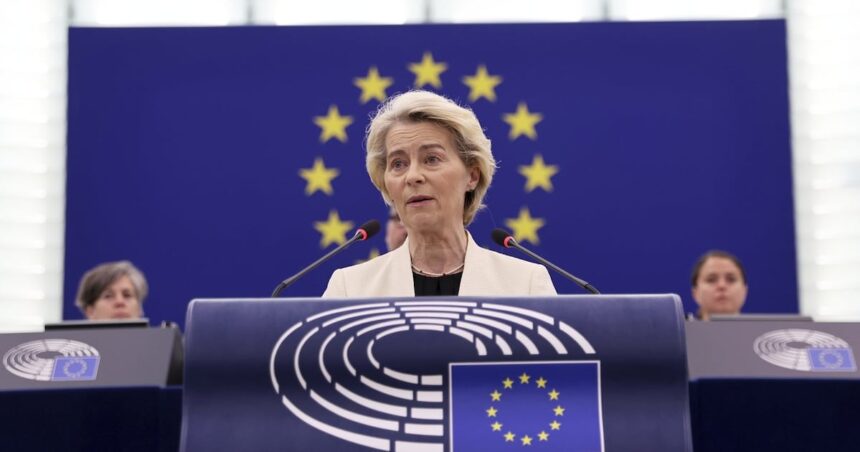The growing trade rift between Brussels and Washington took a significant turn yesterday as European officials prepared to hit back against President Trump’s planned import duties with retaliatory tariffs targeting $109 billion in American goods. Standing at the European Commission headquarters, I watched Trade Commissioner Valdis Dombrovskis outline what could become the most extensive transatlantic trade conflict since 2018.
“We had hoped for cooperation, not confrontation,” Dombrovskis told the assembled press corps, his usually measured tone carrying an edge of frustration. “But we must defend European interests against measures we consider both harmful and contrary to WTO rules.”
Behind the diplomatic language lies a brewing economic storm. The European Union’s planned tariffs would impact everything from Kentucky bourbon to Wisconsin cheese, Texas oil equipment to California tech products. Unlike previous trade disputes, this confrontation comes amid already strained supply chains and economic uncertainty in both regions.
I spoke with Maria Demertzis, senior fellow at Bruegel, the Brussels-based economic think tank, who explained the broader implications. “This isn’t just about tariffs. It’s about the fundamental relationship between two economic powerhouses that have traditionally championed free trade principles. The ripple effects will reach consumers, workers, and industries far beyond the targeted sectors.”
The conflict began escalating after the Trump administration announced plans to impose new 25% tariffs on European automobiles and machinery, citing “national security concerns” – the same justification used during Trump’s first term. What makes this round different is the scale and the context of global economic fragility.
Walking through Brussels’ European Quarter yesterday afternoon, I noticed the tension was palpable even among diplomats typically skilled at maintaining composure. One senior EU official, speaking on condition of anonymity, revealed, “We’ve been preparing these countermeasures since January. Nobody wanted to believe it would come to this, but here we are.”
The European strategy appears carefully calibrated to maximize political pressure. The targeted American goods come disproportionately from swing states like Pennsylvania, Michigan, and Georgia – no coincidence as November elections approach. Yet EU officials insist this isn’t about election interference but strategic leverage.
“The tariffs are designed to create pressure points,” explained Fredrik Erixon, director of the European Centre for International Political Economy. “Europe learned from the previous trade conflicts that targeting politically sensitive industries is the most effective approach when dealing with Washington.”
Data from the U.S. Chamber of Commerce indicates that approximately 900,000 American jobs could be affected if the full slate of tariffs takes effect. Meanwhile, the International Monetary Fund has already reduced global growth forecasts by 0.3 percentage points, citing trade tensions as a key factor.
What makes this situation particularly concerning is the broader context of global economic fragmentation. With China pursuing its own economic sphere of influence and developing nations increasingly caught between competing trade blocs, the EU-US rift threatens to accelerate what the World Trade Organization calls “dangerous economic decoupling.”
During a conversation with German auto industry workers in Munich last week, I heard firsthand about the human impact. “We’ve already weathered COVID disruptions and chip shortages,” said Klaus Weber, a 27-year veteran at a major German automaker. “Now this political fight threatens our livelihoods again. Who wins from this?”
The question of winners is indeed difficult to answer. According to analysis from the Peterson Institute for International Economics, both economies stand to lose significantly, with potential GDP impacts of 0.4% in the EU and 0.3% in the US if tariffs remain in place through 2026.
The European Commission has set September 1 as the deadline for implementing its retaliatory measures, giving a narrow diplomatic window that some observers see as the last chance for de-escalation. Yesterday, I observed French, German, and Italian diplomats huddled in urgent consultation at a café near the Commission headquarters – a visible sign of the coordination happening behind closed doors.
Despite the preparations for economic conflict, channels for negotiation remain open. U.S. Trade Representative Katherine Tai is scheduled to meet with EU counterparts next week in Brussels, though expectations for breakthrough remain low. Previous discussions in June ended without progress.
“The challenge is that both sides see this as a test of resolve,” said Antonio Barroso, managing director at Teneo, a global advisory firm. “Neither wants to be perceived as backing down first, especially with domestic political considerations at play.”
As I prepare to travel to Washington next week to cover the American response, the stakes couldn’t be higher. Beyond the immediate economic consequences lies a deeper question about the future of transatlantic relations in an increasingly fragmented global order. The coming weeks will reveal whether cooler heads can prevail or if consumers and businesses on both sides of the Atlantic will bear the cost of political brinkmanship.
For citizens in Europe and America, the complex diplomatic dance translates to a simple reality: higher prices, potential job insecurity, and economic uncertainty. The true casualties of trade wars are rarely the politicians who initiate them, but the ordinary people caught in the crossfire.






